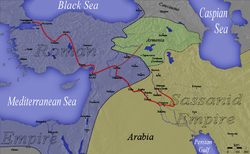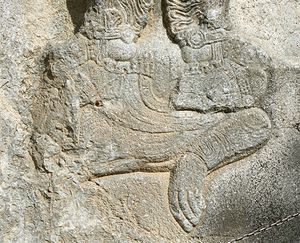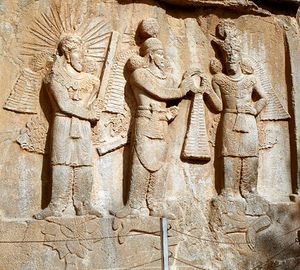حرب يوليان الفارسية
| ||||||||||||||||||||||||||||||||
|
| ||||||||||||||||||||||||||||||||
| قالب:Campaignbox Šāpūr the Great's Campaigns | ||||||||||||||||||||||||||||||||
| قالب:Campaignbox Roman–Sassanid Wars | ||||||||||||||||||||||||||||||||
حرب يوليان الفارسية، أو الحرب الرومانية الفارسية في 363، كانت آخر أعمال الامبراطور الروماني يوليان، وبدأت في مارس 363. وكانت حرباً عدوانية ضد الامبراطورية الفارسية التي كان يحكمها الملك الساساني شاپور الثاني. ويـُعتقد أن شابور كان يتوقع غزواً عن طريق وادي دجلة. وقد أرسل يوليان كتيبة لتنضم لحليفه Arshak II من أرمنيا and take the Tigris route. Meanwhile, with his main army he advanced rapidly down وادي الفرات، meeting only scattered opposition, ووصل أسوار العاصمة الفارسية قطسيفون حيث لاقى وهزم الجيش الفارسي في معركة المدائن (363). Unable to take the city, and with a faltering plan of campaign, Julian was misled by Persian spies into burning his fleet and taking a disadvantageous route of retreat in which his army was constantly harassed and his progress crawled to a halt.
In one of the skirmishes Julian was wounded and later died of his wounds leaving his successor along with his army trapped in Persian territory. The leaderless Roman army chose Jovian as Julian's successor. The new emperor, in light of the "crushing military defeat" the Romans had suffered, was left no option but to agree to humiliating terms in order to save the remnants of his army, and himself, from complete annihilation.[12] The ignominious معاهدة 363 نقلت إلى الحكم الفارسي المدن والحصون الكبرى في Nisibis و Singara, and renounced the alliance with Armenia, giving Shapur de facto authority to invade and annex Arsacid Armenia as a result. وبذلك تـُرِك Arsaces II من أرمنيا بدون أي دعم عسكري أو سياسي. وقد ألقي شابور القبض عليه وحبسه في 368؛ وقد انتحر في 369 أو 370 أثناء وجوده في الأسر الفارسي.
الأهداف والتحضيرات

According to contemporary Roman sources Julian's aim was to punish the Persians for their recent invasion of Rome's eastern provinces; for this reason he refused Shapur's immediate offer of negotiations.[13] Among the leaders of the expedition was Hormizd, a brother of Shapur II, who had fled from the Persian Empire forty years earlier and had been welcomed by the then Roman emperor Constantine I. Julian is said to have intended to place Hormizd on the Persian throne in place of Shapur.[14] A devout believer in the old Roman religion, Julian asked several major oracles about the outcome of his expedition.[15]
The philosopher Sallustius, a friend of Julian, wrote advising him to abandon his plan,[16] and numerous adverse omens were reported; at the urging of other advisers he went ahead.[17] He instructed Arshak II of Armenia to prepare a large army, but without revealing its purpose;[18] he sent Lucillianus to Samosata in the upper Euphrates valley to build a fleet of river ships.[19] These preparations are thought by scholars to have suggested to Shapur that an invasion from the north, by way of the Tigris valley, was Julian's plan.
التقدم
Julian had wintered at Antioch in Roman Syria. On 5 March 363 he set out north-east with his army by way of Aleppo[20] and Manbij, where fifty soldiers were killed in the collapse of a portico while they were marching under it.[21] The whole army mustered there, crossed the middle Euphrates and proceeded to Harran, known to the Romans as Carrhae, site of the famous battle in which the Roman general Crassus was defeated and killed in 53 BC. "From there two different royal highways lead to Persia," writes the eye-witness Ammianus Marcellinus: "the one on the left through Adiabene and across the Tigris; the one on the right through Assyria and across the Euphrates."[22] Julian made use of both. He sent a detachment (numbering 30 000 according to Ammianus but only 18 000 according to Zosimus) under Procopius and Sebastianus towards the Tigris where they were to join Arshak and his Armenian army. They were then to attack the Persians from the north.[23]
Julian himself, with the larger part of his army (which numbered 65,000 although whether that was before or after Procopius' departure is unclear) turned south towards the lower Euphrates, reaching Callinicum (al-Raqqah) on 27 March and meeting the fleet under the command of Lucillianus.[24] There he was met by leaders of the "Saraceni" (Arab nomads), who offered Julian a gold crown. He refused to pay the traditional tribute in return.[25] The army followed the Euphrates downstream to Circesium (the border city) and crossed the river Aboras (الخابور) مستعيناً بـجسر طافي جـُمــِّع لهذا الغرض.
الأحداث
كان حلم يوليان الأخير العظيم أن يفعل ما فعله الإسكندر وتراجان: فيرفع العلم الروماني على العواصم الفارسية، ويقضي القضاء النهائي على الخطر الفارسي الذي كان يهدد أمن الدولة الرومانية وسلامتها. وللوصول إلى هذه الغاية عني أعظم عناية بتنظيم الجيش، وباختيار ضباطه، وترميم الحصون المشيدة على التخوم وخزن المؤن في المدن القائمة على طريق نصره. فلما تم له ذلك جاء إلى إنطاكية في خريف عام 362، وجمع فيها جنوده؛ واغتنم تجار المدينة احتشاد الجنود فيها فرفعوا أسعار الحاجيات، وشكا الناس قائلين "إن كل شيء موفور ولكن كل شيء غالي الثمن". فما كان من يوليان إلا أن استدعى إليه رؤساء الأعمال الاقتصادية وأخذ ينصحهم بالحد من مكاسبهم، فوعدوه بذلك ولكنهم لم يوفوا بوعدهم؛ فلما يئس منهم "حدد ثمناً عادلاً لكل سلعة وأعلنه للناس جميعاً"، ثم عمل على استيراد أربعمائة ألف موديوس من القمح من بلدان سوريا و مصر وأحتج التجار بأن الأثمان التي حددها لم تترك لهم شيئاً من الأرباح، وابتاعوا في الخفاء القمح المستورد، ونقلوه هو وبضاعته إلى مدن أخرى، ووجدت إنطاكية نفسها تزخر بالنقود وتفتقر إلى الطعام. وسرعان ما قام العمة ينددون بيوليان لتدخله في هذه الشؤون، وأخذ الفكهون يسخرون من لحيته ومن انهماكه في خدمة الآلهة الأموات. ورد عليهم يوليان بنشرة أصدرها سماها "كاره اللحى" (Misopogon) حوت من الفكاهة والمتعة ما لا يتفق مع مقام إمبراطور. فقد اعتذر في سخرية عن لحيته، وعنف أهل أنطاكية على وقاحتهم، وطيشهم، وإسرافهم، وفساد أخلاقهم، واستخفافهم بآلهة اليونان. وكانت الحديقة الشهيرة المعروفة باسم دافني Daphne، والتي كانت من قبل مزاراً مقدساً لأبلو، قد حولت إلى مكان للهو والتسلية، فأصدر يوليان أمره أن يمنع اللهو منها وان تعود مزاراً مقدساً كما كانت من قبل؛ وما كاد هذا العمل يتم حتى التهمتها النيران؛ وظن يوليان أن الحريق من فعل المسيحيين فأغلق كنيسة إنطاكية، وصادر أملاكها، وعذب كثيرين من الشهود، وقتل أحد القساوسة. ولم يجد الإمبراطور في إنطاكية سلوى إلا "وليمة العقل" التي اجتمع فيها بليبانيوس.
وفاته

وأخيراً تأهب الجيش للنزول إلى الميدان، وبدأ يوليان الحرب في شهر مارس من عام 363 ، فسار على رأس جيوشه وعبر نهر الفرات ، ثم نهر دجلة ، وطارد الفرس المتقهقرين، ولكنه لاقى الأمرين، وكاد يلاقي الهزيمة من جراء "إجداب الأرض" وهي الخطة التي اتبعها الفرس وأرادوا بها إحراق جميع المحصولات في كل جزء يخلونه من البلاد، حتى كان الجنود يوليان يموتون من الجوع مرة بعد مرة، وقد أظهر الإمبراطور في هذه الحروب المضنية أحسن ما اتصف به من خلال، فكان يشارك جنوده كل ما يعترضهم من صعاب، ويكتفي مثلهم بالقليل وبأقل من القليل ويسير مثلهم على قدميه في القيظ، ويخوض مجاري المياه، ويحارب في الصفوف الأولى في جميع المعارك. وكان من بين الأسرى فارسيات ذوات جمال في نضرة الشباب؛ ولكنه لم يقتحم عليهن خلوتهن، ولم يسمح لإنسان أن يمس بأذى شرفهن. وتقدم الجنود تحت قيادته القديرة حتى طرقوا أبواب قطشيفونة Ctesiphon (المدائن)، وضربوا عليها الحصار، ولكنهم اضطروا إلى الارتداد عنها لعجزهم عن الحصول على الطعام. واختار شابور الثاني رجلين من أشراف الفرس وجدع أنفيهما وأمرهما أن يذهبا إلى يوليان ويدعيا أنهما قد فرا من عند الملك لقسوته عليهما واعتدائه الصارخ على كرامتهما، ثم يقودانه هو وجيشه إلى صحراء جدباء. وفعل الرجلان ما أمرا به، وصدقهما يوليان وسار خلفهما هو وجيشه مسافة عشرين ميلاً حتى وجد نفسه في صحراء جدباء لا ماء فيها ولا نبات، وبينا كان يحاول إنقاذ رجاله من هذا الفج الذي نصب له هاجمته قوة من الفرس، ولكنه صد هجومها وردها على أعقابها، وفر الفرس لا يلوون على شيء. وكان يوليان في مقدمة المطاردين غير عابئ بأنه ليس على جسمه دروع: فأصابته حربة في جنبه نفذت إلى كبده، فسقط على ظهر جواده وحمل إلى الخيمة، وأنذره طبيبه بأنه لن تطول حياته أكثر من بضعة ساعات. ويقول ليبانيوس إن الذي رماه بالحربة رجل مسيحي، ومما هو جدير بالذكر أن أحداً من الفرس لم يطالب بالمكافأة التي وعد بها شابور من يقتل الإمبراطور. ومن المسيحيين من يؤيد رواية ليبانيوس ويثني على القاتل "الذي أقدم على هذا العمل الجريء حباً في الله وفي الدين" ، ومن هؤلاء سوزومين Sozomen. وكانت الساعة الأخيرة من حياة يوليان خليقة بتقاليد سقراط وسنكا، وقد وصفها أميانوس فقال: إن يوليان وهو مسجى في خيمته خاطب رفاقه المحزونين الذين ملك الأسى قلوبهم بقوله: "أيها الأصدقاء، إن هذه الساعة لهي أنسب الأوقات التي أغادر فيها هذه الحياة، وأردها إلى الطبيعة بعد أن طلبت ردها إليها"... وبكى جميع الحاضرين فلامهم على بكائهم محتفظاً حتى في تلك الساعة بسلطانه عليهم، وقال لهم أنه لا يليق بهم أن يحزنوا من أجل زعيم دعي للاتحاد بالسماء وبالنجوم. ولما أن أسكنهم بقوله هذا دخل مع الفيلسوفين مكسموس وبرسكوس في حوار دقيق عن شرف النفس ونبلها. وفي أثناء هذا النقاش اتسع الجرح الذي في جنبه فجاءةً، وحال ضغط الدم المتدفق بينه وبين التنفس؛ وبعد أن تناول جرعة من الماء البارد طلبها إلى الحاضرين أسلم الروح وكان في الثانية والثلاثين من عمره .
وكان الجيش لا يزال معرضاً للخطر وفي حاجة إلى قائد، فاختار زعماؤه جوفيان Jovian قائد الحرس الإمبراطوري. وعقد الإمبراطور الجديد الصلح مع فارس، بأن رد إليها أربعاً من الولايات الخمس التي انتزعها منها دقلديانوس منذ سبعين عاماً. ولم يضطهد جوفيان إنساناً، ولكنه لم يلبث أن حول تأييده من الهياكل الوثنية إلى الكنيسة المسيحية. واحتفل مسيحيو أنطاكية بموت الإمبراطور الوثني احتفالاً عاماً أظهروا فيه الفرح والابتهاج(57)، وإن كان زعماء المسيحيين المنتصرين كانوا في معظم الأحوال يحضون جماعات المصلين أن يكونوا كراماً، وأن ينسبوا ما أصاب المسيحية من أذى. وانقضت بعد ذلك أحد عشر قرناً قبل أن تشهد المسيحية يوماً آخر كهذا اليوم.
الهامش
- ^ Beate Dignas & Engelbert Winter, "Rome & Persia in Late Antiquity; Neighbours & Rivals", (Cambridge University Press, English edition, 2007), p131.
- ^ Potter, David S., "The Roman Empire at Bay, AD 180-395", Routledge, First Edition, (Taylor & Francis Group, 2004), p520 & p527
- ^ Potter, David S., "The Roman Empire at Bay, AD 180-395", Routledge, First Edition, (Taylor & Francis Group, 2004), p520
- ^ Ammianus Marcellinus,xxv.7.9-14, ed. W. Seyfarth, (Leipzig 1970-8; repr.1999)
- ^ Ammianus Marcellinus,xxv.7.9-14, ed. W. Seyfarth, (Leipzig 1970-8; repr.1999)
- ^ http://www.iranicaonline.org/articles/sasanian-dynasty
- ^ R. Ernest Dupuy and Trevor N. Dupuy, The Harper Encyclopedia of Military History, (HarperCollins, 1993), 168.
- ^ R. Ernest Dupuy and Trevor N. Dupuy, The Harper Encyclopedia of Military History, p168.
- ^ R. Ernest Dupuy and Trevor N. Dupuy, The Harper Encyclopedia of Military History.
- ^ Ghafouri, Ali. "Tarikh-e Janghay-e Iran; Az Madha ta be Emrouz", Entesharat Etela'at 1388, ISBN 964-423-738-2, p176.
- ^ Ghafouri, Ali. "Tarikh-e Janghay-e Iran; Az Madha ta be Emrouz", The History of Persia's Wars; From the Medes to the Present", Entesharat Etela'at 1388, p176.
- ^ Beate Dignas & Engelbert Winter, "Rome & Persia in Late Antiquity; Neighbours & Rivals", (Cambridge University Press, English edition, 2007), p94, p131 & p134
- ^ Libanius, Orations 17.19, 18.164
- ^ Libanius, Letters 1402.3
- ^ Theodoret, Ecclesiastical History 3.21-25
- ^ Ammianus Marcellinus, Res gestae 23.5.4
- ^ Ammianus Marcellinus, Res gestae 23.5.10; Socrates Scholasticus, Ecclesiastical History 3.21.6
- ^ Ammianus Marcellinus, Res gestae 23.2.2; Libanius, Orationes 18.215; Sozomen, Ecclesiastical History 6.1.2
- ^ Magnus of Carrhae FGrH 225 F 1 (Malalas, Chronography 13 pp. 328-329)
- ^ Dodgeon and Lieu (1991) p. 231
- ^ Ammianus Marcellinus, Res gestae 23.2.6
- ^ Ammianus Marcellinus, Res gestae 23.3.1
- ^ Ammianus Marcellinus, Res gestae 23.3.4-5; Zosimus, New History 3.12.3-5; Sozomen, Ecclesiastical History 6.1.2
- ^ Ammianus Marcellinus, Res gestae 23.3.6-9; Zosimus, New History 3.13.1-3
- ^ Ammianus Marcellinus, Res gestae 23.3.8, 25.6.10
ببليوگرافيا
- R. Andreotti, "L'impresa di Iuliano in Oriente" in Historia vol. 4 (1930) pp. 236–273
- Timothy D. Barnes, Ammianus Marcellinus and the Representation of Historical Reality (Ithaca: Cornell University Press, 1998. ISBN 0-8014-3526-9) pp. 164–165
- Glen Warren Bowersock, Julian the Apostate (Cambridge, Mass.: Harvard University Press, 1978. ISBN 0-674-48881-4) pp. 106–119 Preview في كتب گوگل
- J. den Boeft, J. W. Drijvers, D. den Hengst, H. C. Teitler, Philological and Historical Commentary on Ammianus Marcellinus XXIV. Leiden: Brill, 2002 Preview في كتب گوگل
- Walter R. Chalmers, "Eunapius, Ammianus Marcellinus, and Zosimus on Julian's Persian Expedition" in Classical Quarterly n.s. vol. 10 (1960) pp. 152–160
- Franz Cumont, "La marche de l'empereur Julien d'Antioche à l'Euphrate" in F. Cumont, Etudes syriennes (Paris: Picard, 1917) pp. 1–33 Text at archive.org
- L. Dillemann, "Ammien Marcellin et les pays de l'Euphrate et du Tigre" in Syria vol. 38 (1961) p. 87 ff.
- M. H. Dodgeon, S. N. C. Lieu, The Roman Eastern Frontier and the Persian Wars: 363-628 AD: a narrative sourcebook (London: Routledge, 1991) pp. 231–274 Preview (with different page numbers) في كتب گوگل
- Ch. W. Fornara, "Julian's Persian Expedition in Ammianus and Zosimus" in Journal of Hellenic Studies vol. 111 (1991) pp. 1–15
- David Hunt, "Julian" in Cambridge Ancient History vol. 13 (1998. ISBN 0521302005) pp. 44–77, esp. pp. 75–76 Preview في كتب گوگل
- W. E. Kaegi, "Constantine's and Julian's Strategies of Strategic Surprise against the Persians" in Athenaeum n.s. vol. 69 (1981) pp. 209–213
- Erich Kettenhofen, "Julian" in Encyclopaedia Iranica Online (2009-2012)
- John Matthews, The Roman Empire of Ammianus (Baltimore: Johns Hopkins University Press, 1989. ISBN 9780801839658) pp. 140–161
- A. F. Norman, "Magnus in Ammianus, Eunapius, and Zosimus: New Evidence" in Classical Quarterly' n.s. vol. 7 (1957) pp. 129–133
- F. Paschoud, ed., Zosime: Histoire nouvelle. Vol. 2 pars 1. Paris: Les Belles Lettres, 1979 (Collection Budé)
- David S. Potter, The Roman Empire at Bay: AD 180-395 (London: Routledge, 2004. ISBN 9780415100571) pp. 518 et 720 Preview في كتب گوگل
- R. T. Ridley, "Notes on Julian's Persian Expedition (363)" in Historia vol. 22 (1973) pp. 317–330 esp. p. 326
- Gerhard Wirth, "Julians Perserkrieg. Kriterien einer Katastrophe" in Richard Klein, ed., Julian Apostata (Darmstadt, 1978) p. 455 ff.

